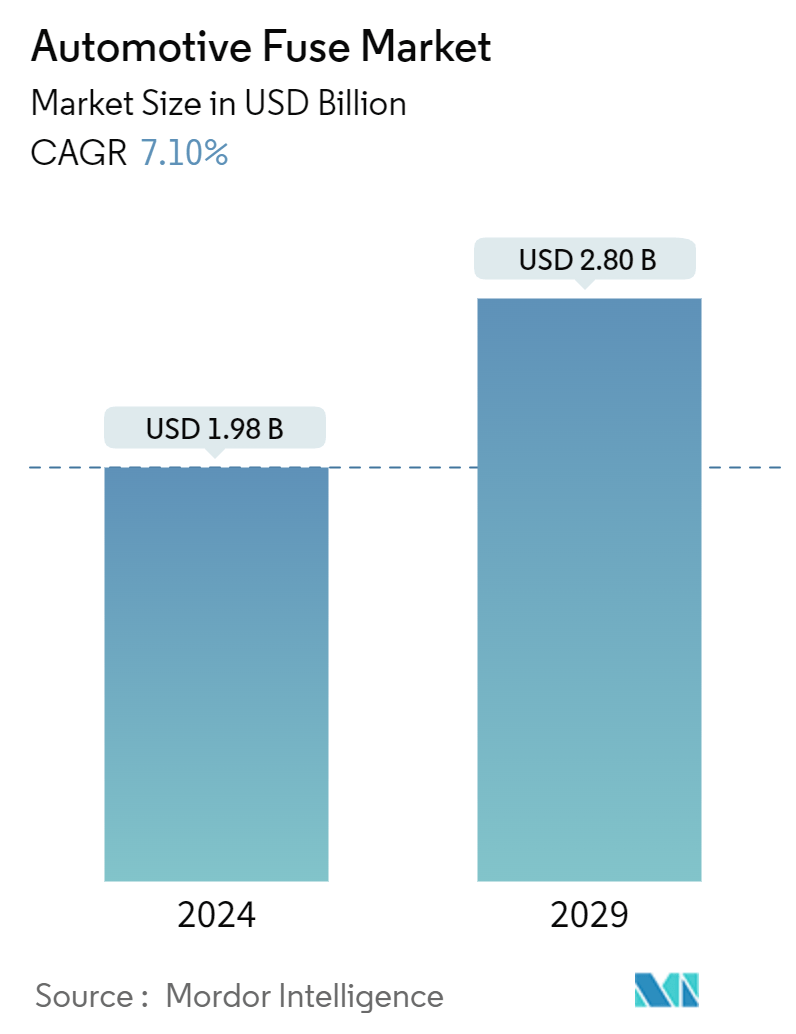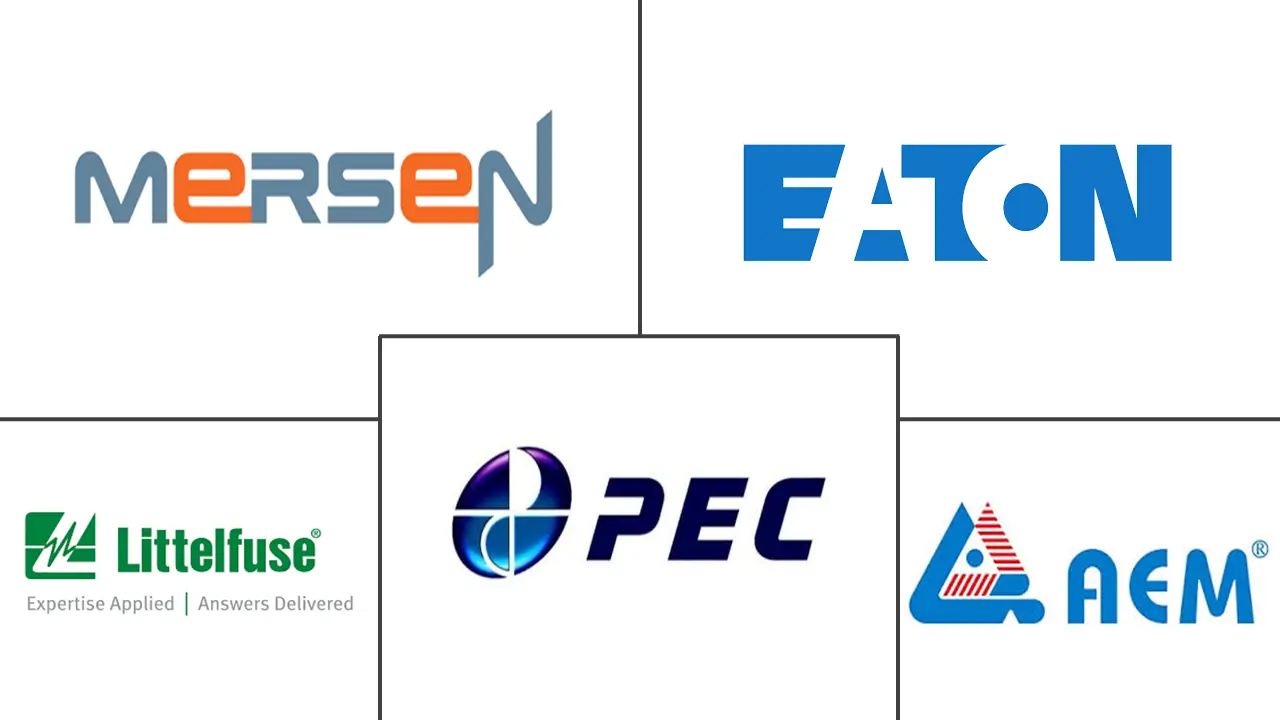Market Size of Automotive Fuse Industry

| Study Period | 2019 - 2029 |
| Market Size (2024) | USD 1.98 Billion |
| Market Size (2029) | USD 2.80 Billion |
| CAGR (2024 - 2029) | 7.10 % |
| Fastest Growing Market | Asia Pacific |
| Largest Market | Asia Pacific |
Major Players
*Disclaimer: Major Players sorted in no particular order |
Automotive Fuse Market Analysis
The Automotive Fuse Market size is estimated at USD 1.98 billion in 2024, and is expected to reach USD 2.80 billion by 2029, growing at a CAGR of 7.10% during the forecast period (2024-2029).
Automotive fuses safeguard a vehicle's wiring and electrical components. Typically set at 32 volts DC, these fuses can operate at 42 volts. Housed in one or more fuse boxes, they are usually located on one side of the engine compartment or under the dashboard near the steering wheel. These fuses protect against short circuits and over-currents, disconnecting the circuit upon detecting potentially dangerous current levels.
• Automotive fuses protect electrical circuits from overcurrent and short-circuit situations. Essential for all vehicle types, from commercial trucks to passenger cars, the automotive fuse market is poised for rapid expansion in the coming years. This growth is driven by several factors: the surging popularity of electric vehicles, an increasing demand for advanced safety features, and the escalating complexity of automotive electrical systems.
• The automotive industry underwent a significant transformation with the introduction of electrification and autonomous driving technologies. This evolution is driving the demand for automotive fuses, which are critical components for ensuring the safety and reliability of modern vehicles.
• Technological advancements in the automotive industry, the rise of driverless cars, and the integration of Internet of Things (IoT) technologies further drive the demand for automotive fuses. These advancements require robust circuit protection methods to maintain the dependability and integrity of vehicle electronics. Innovations in fuse technology, particularly those catering to the needs of electric and hybrid vehicles, are expected to propel the growth of the market.
• Despite modern vehicles' growing complexity and electrical demands, advancements in low-voltage fuse technology have lagged. Modern vehicles incorporate numerous electronic systems, such as advanced driver-assistance systems (ADAS), infotainment systems, and electric powertrains, which require robust and reliable fuses. However, this technological gap limits the fuses' ability to cater to the evolving requirements of today's automotive electrical systems.
• The anticipated growth in automotive production is projected to decelerate in 2024 due to a decline in demand, especially within advanced economies. The ongoing high interest rates are exerting pressure on both automotive production and sales as household incomes continue to be strained and financing options have become increasingly expensive. Furthermore, as existing order backlogs are fulfilled, a reduction in demand for automotive production is expected in 2024 and 2025. The sector faces significant downside risks, including persistent inflation and potential component shortages that may disrupt automotive supply chains.
Automotive Fuse Industry Segmentation
Automotive fuses safeguard a vehicle's wiring and electrical components. Typically set at 32 volts DC, these fuses can also operate at 42 volts. Housed in one or more fuse boxes, they are usually located on one side of the engine compartment or under the dashboard near the steering wheel. These fuses protect against short circuits and overcurrents, disconnecting the circuit upon detecting potentially dangerous current levels. The study monitors the revenue generated by the global sales of automotive fuse markets.
The automotive fuse market is segmented by type (blade, glass, slow blow, high-voltage fuses, chip fuse, other types), type of vehicle (passenger cars ((traditional-ICE)), commercial vehicles ((traditional-ICE)), electric/hybrid vehicles), and geography (North America [United States and Canada], Europe [Spain, Germany, and France, rest of Europe], Asia-Pacific [China, India, Japan, rest of Asia-Pacific], Latin America, and Middle East and Africa). The market sizes and forecasts are provided in terms of value (USD) for all the above segments.
| By Type | |
| Blade | |
| Glass | |
| Slow Blow | |
| High-Voltage Fuses | |
| Chip Fuse | |
| Other Types |
| By Type of Vehicle | |
| Passenger Cars (Traditional -ICE) | |
| Commercial Vehicles (Traditional -ICE) | |
| Electric/Hybrid Vehicles |
| By Geography*** | |||||
| |||||
| |||||
| |||||
| Australia and New Zealand | |||||
| Latin America | |||||
| Middle East and Africa |
Automotive Fuse Market Size Summary
The Automotive Fuse Market is poised for significant growth, driven by the increasing production of vehicles and the rising demand for electric and hybrid cars. This expansion is largely attributed to the heightened focus on vehicle electrification, safety, and comfort features, which necessitate a greater number of fuses per vehicle. The market is further bolstered by the growing popularity of electric vehicles (EVs), which require advanced electronic systems and, consequently, more fuses. The shift towards EVs is supported by government incentives and regulations aimed at reducing emissions and promoting sustainable transportation solutions. As a result, the automotive fuse market is expected to experience robust growth over the forecast period.
Regionally, Asia-Pacific is anticipated to hold a substantial share of the automotive fuse market, fueled by the presence of major car manufacturers in countries like China, India, and Japan. Government initiatives in these regions are promoting the adoption of electric vehicles, thereby driving demand for automotive fuses. The market landscape is characterized by a semi-consolidated structure, with numerous local manufacturers and key players such as Eaton Corporation, Littelfuse Inc., and Pacific Engineering Corporation leading the charge. Innovations in fuse technology, particularly those catering to the needs of electric and hybrid vehicles, are expected to further propel market growth. Despite challenges such as fluctuating raw material prices and an unorganized aftermarket, the overall outlook for the automotive fuse market remains positive, with significant opportunities anticipated in the coming years.
Automotive Fuse Market Size - Table of Contents
-
1. MARKET INSIGHTS
-
1.1 Market Overview
-
1.2 Industry Attractiveness - Porter's Five Forces Analysis
-
1.2.1 Bargaining Power of Suppliers
-
1.2.2 Bargaining Power of Buyers
-
1.2.3 Threat of New Entrants
-
1.2.4 Threat of Substitutes
-
1.2.5 Intensity of Competitive Rivalry
-
-
1.3 Impact of COVID-19 Aftereffects and Other Macroeconomic Factors on the Market
-
-
2. MARKET SEGMENTATION
-
2.1 By Type
-
2.1.1 Blade
-
2.1.2 Glass
-
2.1.3 Slow Blow
-
2.1.4 High-Voltage Fuses
-
2.1.5 Chip Fuse
-
2.1.6 Other Types
-
-
2.2 By Type of Vehicle
-
2.2.1 Passenger Cars (Traditional -ICE)
-
2.2.2 Commercial Vehicles (Traditional -ICE)
-
2.2.3 Electric/Hybrid Vehicles
-
-
2.3 By Geography***
-
2.3.1 North America
-
2.3.1.1 United States
-
2.3.1.2 Canada
-
-
2.3.2 Europe
-
2.3.2.1 France
-
2.3.2.2 Germany
-
2.3.2.3 Spain
-
-
2.3.3 Asia
-
2.3.3.1 China
-
2.3.3.2 Japan
-
2.3.3.3 India
-
-
2.3.4 Australia and New Zealand
-
2.3.5 Latin America
-
2.3.6 Middle East and Africa
-
-
Automotive Fuse Market Size FAQs
How big is the Automotive Fuse Market?
The Automotive Fuse Market size is expected to reach USD 1.98 billion in 2024 and grow at a CAGR of 7.10% to reach USD 2.80 billion by 2029.
What is the current Automotive Fuse Market size?
In 2024, the Automotive Fuse Market size is expected to reach USD 1.98 billion.

